Article originally published on culturainrivera.it
Like a year ago. The meeting with Steve McCurry in Castelnuovo Magra was once again filled with interesting insights, an opportunity to reflect on the variety of the world around us and how we live thousands of miles away, a way to learn more about the personality, technique and thinking of one of the world’s greatest photographers. Under the Bishops’ Castle in Luni, in front of an audience of more than a thousand people gathered in the charming Piazza Querciola in the Ligurian village, which for the occasion became a kind of amphitheater that embraced the American artist for almost two hours, Steve McCurry commented for those present on some of the symbolic images of his career. Many of them featured in the Football and Icons exhibition that will remain open, in the Castle Tower, until Sept. 11.
For those who missed the meeting last night, we offer below a portion of Steve McCurry’s narrative, linked to some of the artist’s most beautiful photographs to tell the audience. What emerges is a portrait of a tireless traveling photographer, perpetually discovering the world with his equipment, also capable of risking his life on several occasions, and able to remain fascinated everywhere, even in places visited dozens of times already.
 |
| The stage set up for Steve McCurry in Castelnuovo Magra in Querciola Square |
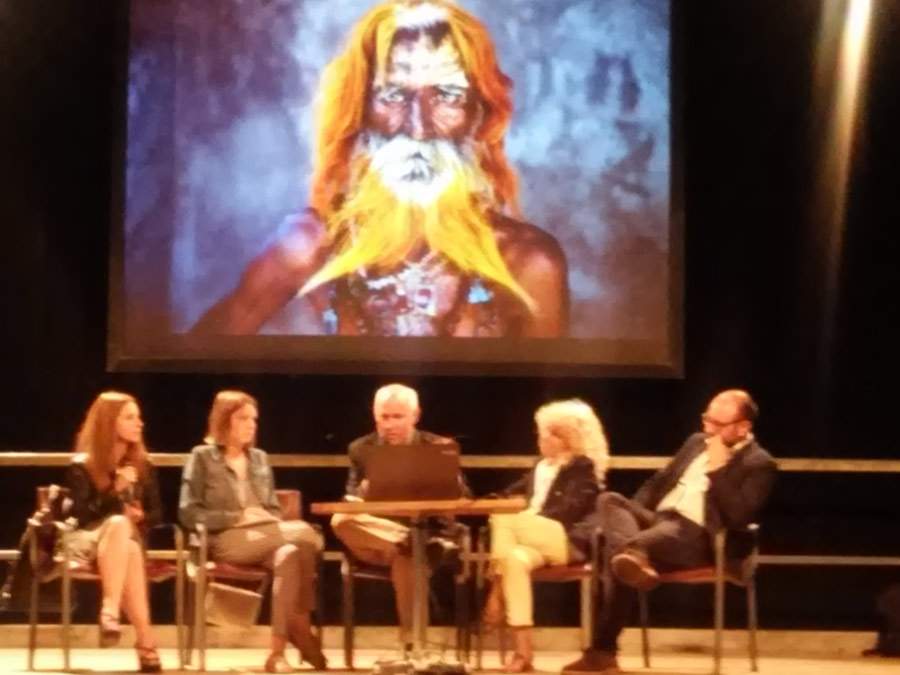 |
| Steve McCurry with exhibition curator Biba Giacchetti, Castelnuovo Mayor Daniele Montebello, and the two interpreters who translated the photographer’s talk for the audience |
Sittwe, Burma, 1995
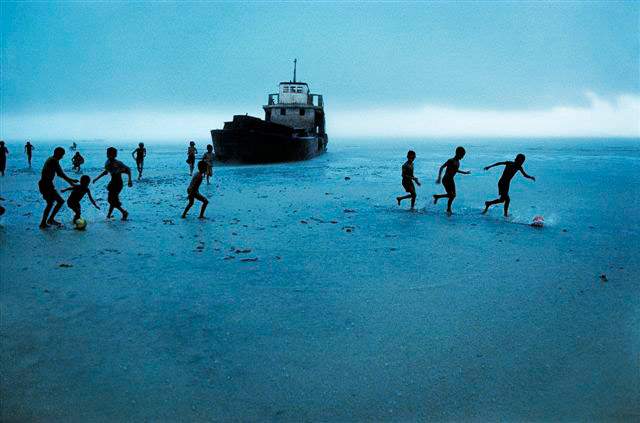 |
| Steve McCurry, Sittwe, Burma, 1995 |
Meanwhile, for me it is a source of great honor, pride and happiness to be hosted here in Castelnuovo Magra, with an exhibition related to soccer, a theme to which I am very attached. Why specifically soccer? Well, the beautiful thing about soccer is the fact that it is a universal language, it is a kind of common denominator that unites all places in the world. I basically wanted to combine two universal languages: soccer and photography. Like soccer, photography can be understood whatever language you speak, and each person is able to provide their own interpretation of an image.
In this photo, which I took in Burma, you can see children kicking a ball on a beach and simply having fun. In the background is a shipwreck, one of my favorite subjects. Biba Giacchetti [the curator of the Football and Icons exhibition, ed.] thinks this is one of the most beautiful photos in the exhibition because among the players you can see, on the left, a small child, the one running with the yellow ball, who is getting away from two kids older than him. He does this with great cunning, showing that often even if you are smaller you cannot necessarily get the better of those who start in an advantageous condition. It is, in short, a metaphor for life, leading us to identify with that small child and take his side.
An interesting thing about this photo is that it was taken at a time when it was raining very hard: you cannot see it from the photo, because you cannot perceive the rain falling in abundance, but the weather was certainly not the best at the time of the shot... !
Jodhpur, India, 2007
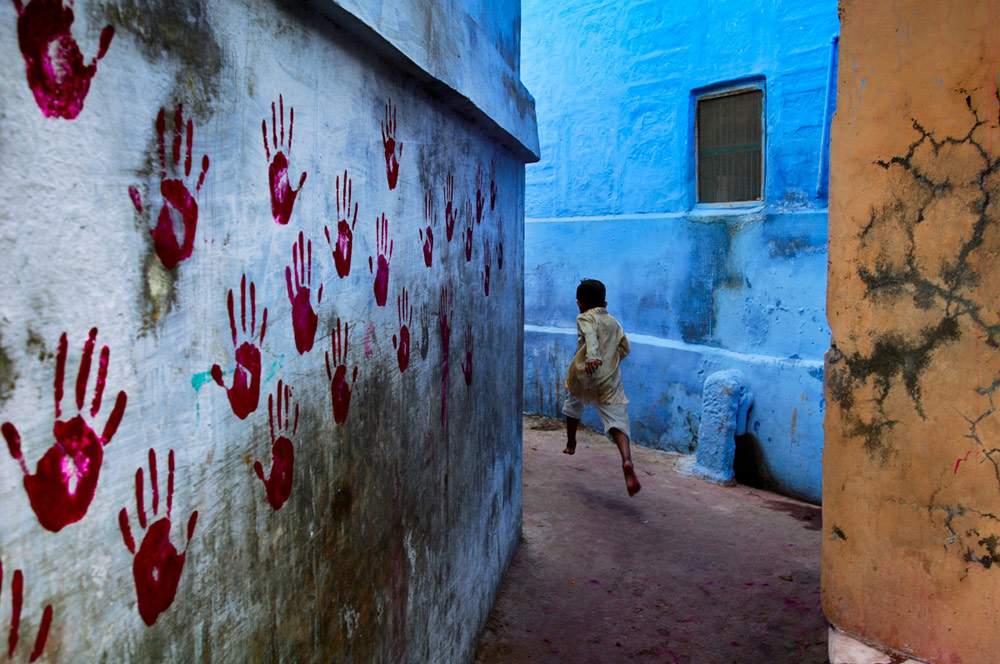 |
| Steve McCurry, Jodhpur, India, 1997 |
This photo features a child playing in an alley in Jodhpur, India. I particularly love this photo: as I was walking through the streets of the city, I happened upon this colorful alley where there were all these red handprints, and I immediately thought it might be a good place to take a photograph. So I stopped to capture images of the people passing by on this street.
When I find a scenery that fascinates me, I am also able to lurk there for several hours before I find the right moment to take a photograph, because I am waiting for something to happen that will catch my attention. I remember that in order to take this photograph I stayed on that street corner for at least one or two hours. And in those two hours during which I stood still behind my equipment, I saw everything go by: objects, people, animals, especially cows.
One of the interesting things about India is its vibrant colors, it’s a magnificent thing: that’s also why I spent several years in India photographing, often making train journeys across the country, in sometimes extreme conditions, but still being in contact with the locals. There are also many contrasts: it is a country where you can really see the difference between the wealthy families, who ride around in luxury cars and live in lavish homes, and the poor who instead live on the edges of the streets, setting up almost makeshift houses in the corners of alleys, where they socialize, cook, eat, sleep, in short spend their existence. With my photography I also wanted to document this reality.
Porbandar, Gujarat, India, 1983
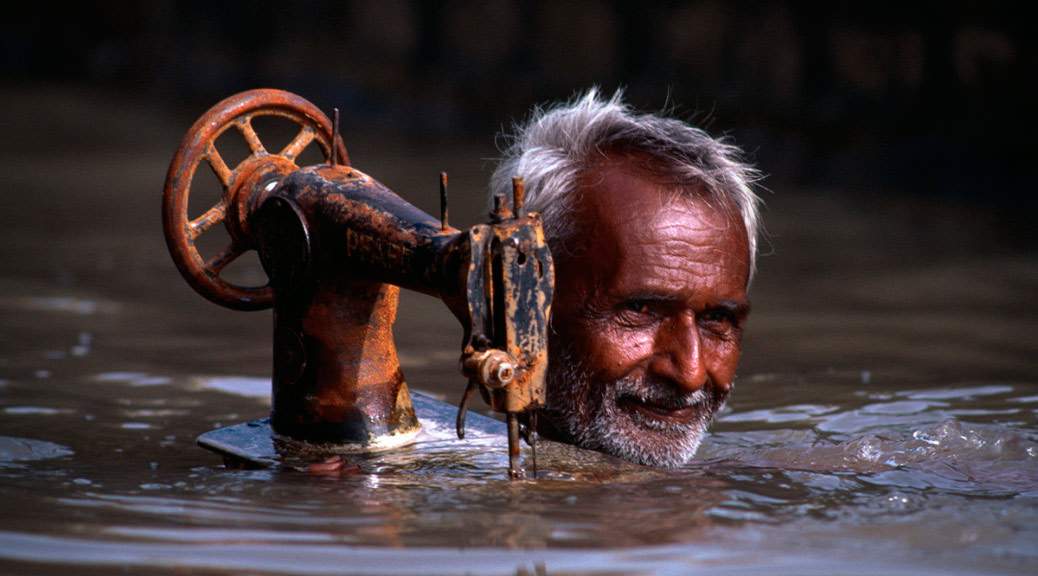 |
| Steve McCurry, Porbandar, Gujarat, India, 1983 |
When I was a young boy I was given a book of photographs by Brian Brake all dedicated to the monsoons: and that gift was instrumental in making me choose the profession I have today, that of photographer. Those photographs fascinated me quite a bit, and I also decided, when I could, to go to Asia to document the monsoons. In fact: my first personal project was really dedicated to monsoons [nda: Biba Giacchetti was pointing out to the audience that soon there will be, in New Zealand, an exhibition on monsoons that will feature shots by Steve McCurry and Brian Brake].
I was saying before that India is the country of contrasts. And this is also the case in terms of climate, because you go from the dry season, when everything is dry and one of the biggest problems is drought, to the monsoon season, when heavy rains flood everything creating huge new problems for the population. For a photographer to document an unfolding monsoon is very difficult, because you have to spend a lot of time in the heavy rain, trying to take shelter as much as possible, even simply standing under an umbrella, for what it may take, and then spending a lot of time wet, with the equipment constantly in danger of being damaged and constantly having to change the camera lenses.
In this photo I portrayed a tailor who was trying to get his sewing machine to safety. The manufacturing company, through the photo, was able to recognize the machine and decided to give this person a new one. When I took this picture I was slightly higher than the tailor, I was standing on top of a step, but still even I was almost completely wet. You cannot imagine how dirty the water was, I saw everything floating in it, even dead animal carcasses. But after all, in order to take true and faithful pictures it is also necessary to undergo this kind of adversity. In this case I also feared contracting some disease, precisely because of the disastrous hygienic conditions of the water in which I had to immerse myself.
Porbandar, Gujarat, India, 1983
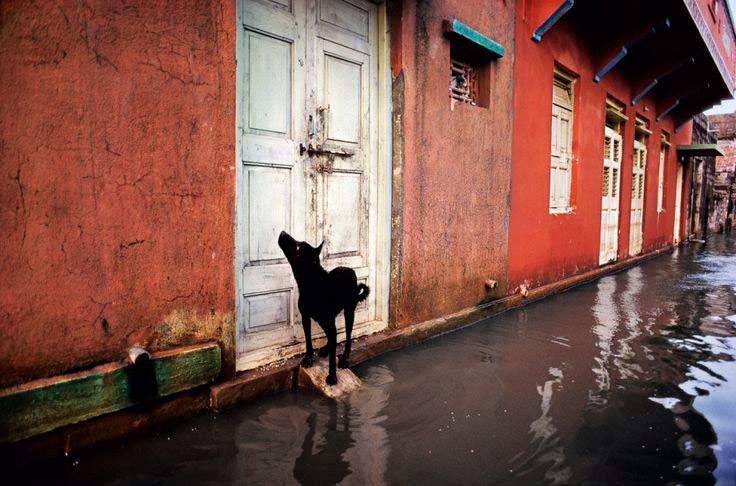 |
| Steve McCurry, Porbandar, Gujarat, India, 1983 |
This photograph was also taken on the same occasion as the one I showed you just now. I really love this photograph because the dog is behaving exactly as a human being would: he is in front of the door waiting to enter the house to get out of the rain, we see him just anxious to enter, with his snout facing the door.
However, even though these photographs were taken in the same place, I often take pictures of the same situations in different places, partly because monsoons do not only affect India but also affect much of Asia, from Bangladesh to the Philippines via Burma. As mentioned earlier, the language of photography is universal, and so the stories I tell with my shots also take on a kind of universal significance.
Rajasthan, India, 2010
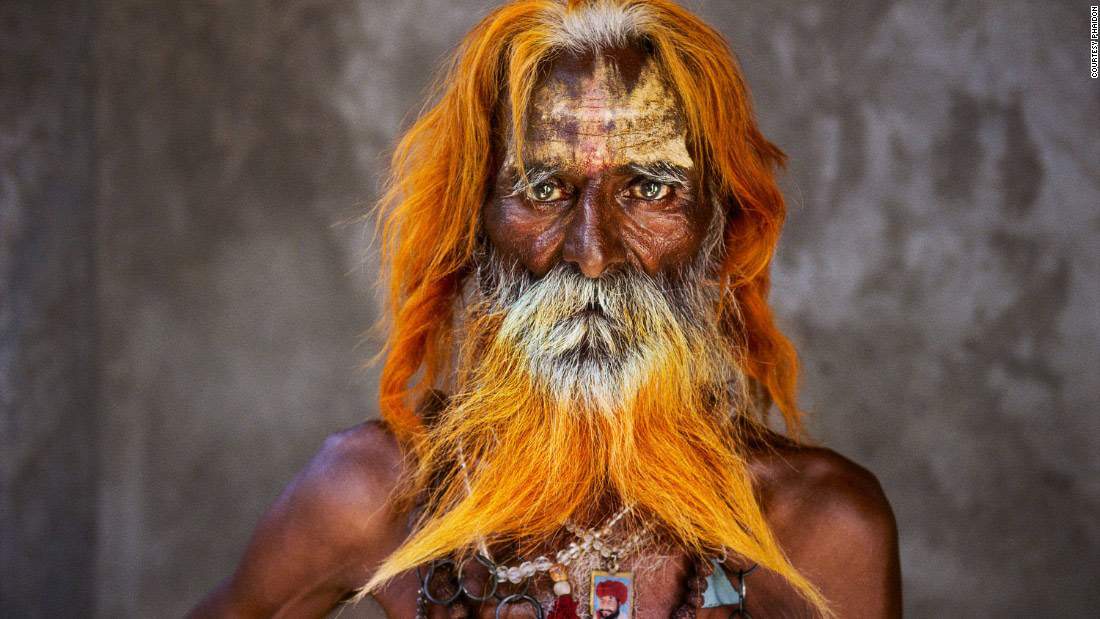 |
| Steve McCurry, Rajasthan, India, 2010 |
I have always had a kind of obsession with portraits of people in their own spaces. In this photo taken in Rajasthan in 2010, I wanted to portray a man from the rabari community-they are nomads who move through this region of northern India and spend their lives in poverty. However, as I have also found in other parts of the world, for example in Tibet, despite the fact that many people live in even extreme poverty, attention to aesthetics and outward appearance is also taken care of with great care.
In this case, the man has a beard and hair of this bright orange color because there is a custom among this population of dyeing their hair and beard with henna when they whiten.
Weligama, Sri Lanka, 1995
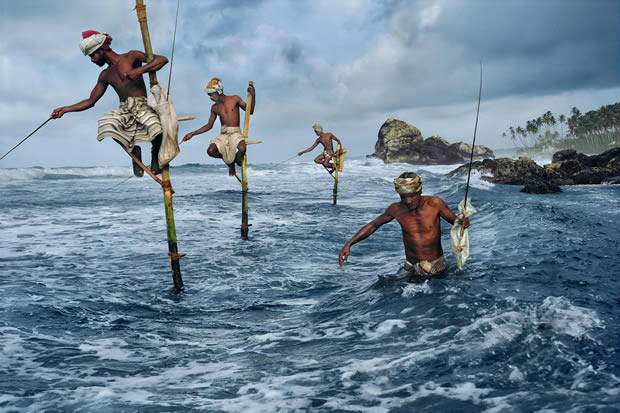 |
| Steve McCurry, Weligama, Sri Lanka, 1995 |
One thing I find curious in my work as a photographer is to see how in every part of the world the same, identical activities are done, but they are done in ways that change completely and are entirely different from one area to another.
These men I photographed in Sri Lanka are fishermen, and in order to catch fish they use this very particular method, which is that they stand on top of poles driven into the water and from there they cast their nets, waiting for the fish to come in. It sounds like an awkward position but I can assure you that it is a very effective method because I could see them coming back with full nets. Again, I had to take the picture in subjective, so I had to submerge myself in the water.
Kuwait, 1991
 |
| Steve McCurry, Kuwait, 1991 |
This photo was taken during the first Gulf War, in Kuwait. We don’t imagine that wars often bring devastation to the environment as well, and here I wanted to photograph an environmental disaster, with bombings that had hit oil wells causing explosions, oil spills and devastation. In the picture, the dromedaries appear to be stationary but they were actually trying to find an escape route to escape from the explosions, it was a very hectic and difficult situation.
In Kuwait during the war I wanted to take several pictures of animals in distress: in addition to the dromedaries there were horses that were similarly trying to escape, but I also unfortunately saw many birds dying in the oil-laden waterways, they thought they were swimming in lakes filled with water but in fact they were drowning from the oil leaking from the bomb-damaged pipelines.
Afghan Girl, 1984
 |
| Steve McCurry, Afghan Girl, 1984 |
After we published the photograph of the Afghan Girl, I remember people from all over the world wrote to us [to National Geographic, the magazine in which the photo was published, ed] to ask how they could help, even with money and clothes or whatever...and it went on for years. Of that photograph I remember the great shyness that Sharbet [the girl’s name] showed in front of the camera. There is one more photograph, taken while we were rehearsing, which shows her hiding her face with her hands. Then also thanks to the help of her teacher, because the photo was taken in the classroom where the girl was studying, in a school set up in a refugee camp, we managed to convince her to pose for a shot. The result is the photo that is famous all over the world today. I took this photo with a very simple Nikon camera set up on a tripod.The main difficulty was the darkness of the setting; we were in a very dark environment and had to do several tests to set up the correct setup.
About 20 years later we thought of visiting Sharbat again. We therefore went back to Afghanistan, where we met her brother, who provided us with valuable information about her and we were therefore able to find her again. The meeting, two decades later, was really exciting [nda: Steve McCurry has spoken on several occasions about his 2002 meeting with Sharbat Gula, including last year in Castelnuovo Magra, when he stated that “it was really very nice for us to meet again. And do you know why? Because if we met again almost two decades later, it means that both of us were still alive.”].
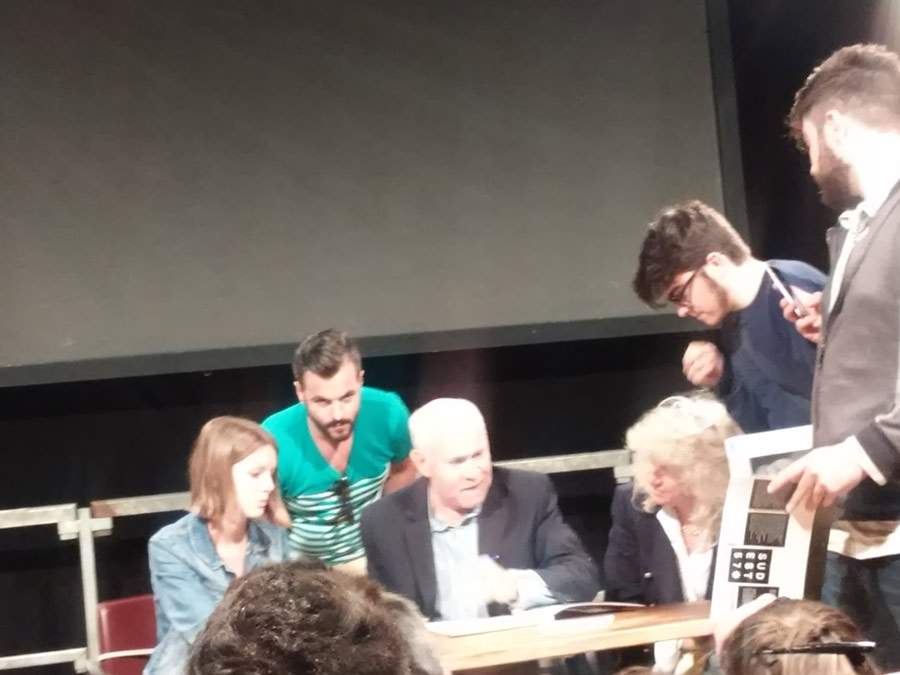 |
| Steve McCurry signs autographs for the audience after his talk |
Warning: the translation into English of the original Italian article was created using automatic tools. We undertake to review all articles, but we do not guarantee the total absence of inaccuracies in the translation due to the program. You can find the original by clicking on the ITA button. If you find any mistake,please contact us.